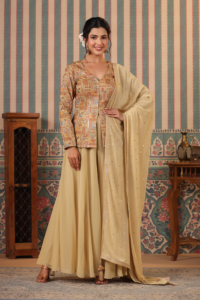The Timeless Elegance of Women’s Sarees: A Cultural Tapestry

The saree, a traditional Indian garment, has been the epitome of grace, beauty, and cultural richness for centuries. Worn by women across the Indian subcontinent, the saree holds a special place in the hearts of millions. Its versatility, cultural significance, and timeless elegance make it cherished attire for various occasions. In this article, we delve into the world of women’s sarees, exploring their history, styles, and enduring appeal.
Historical Significance:
The origin of the saree can be traced back to ancient India, with references found in ancient texts and sculptures. Over the centuries, the saree has evolved in terms of fabric, draping styles, and embellishments, yet its essence remains deeply rooted in tradition. It has witnessed the changing tides of history and fashion, adapting to various influences while retaining its cultural identity.
Diverse Draping Styles:
One of the unique aspects of the saree is its versatility in draping styles. Different regions in India have their own distinct ways of draping a saree, each reflecting the local culture and traditions. The Nivi style from Andhra Pradesh, the Gujarati seedha pallu, and the Bengali style are just a few examples. The variety of draping styles adds to the allure of the saree, making it a canvas for artistic expression.
Fabrics and Embellishments:
Sarees come in a plethora of fabrics, ranging from luxurious silk to comfortable cotton. Each fabric has its own charm and is chosen based on the occasion and personal preference. Silk sarees, such as Banarasi, Kanjeevaram, and Chanderi, are often worn during weddings and special ceremonies for their opulence and sheen.
Embellishments play a crucial role in enhancing the beauty of sarees. Zari work, embroidery, sequins, and intricate thread work are some common embellishments that add a touch of glamour to the saree. The craftsmanship involved in creating these embellishments often reflects the skill and artistry of the weavers.
Modern Interpretations:
While the saree is deeply rooted in tradition, it has seamlessly adapted to modern trends. Contemporary designers have redefined the saree, experimenting with unconventional fabrics, innovative draping styles, and fusion elements. Sarees with modern cuts, digital prints, and contemporary motifs have become popular among the younger generation, bridging the gap between tradition and modernity.
Global Appeal:
The allure of the saree extends beyond the borders of India, captivating the interest of fashion enthusiasts worldwide. International designers have incorporated saree elements into their collections, leading to a global appreciation for this iconic garment. Bollywood celebrities, who often showcase designer sarees at international events, contribute to the saree’s global popularity.
Conclusion:
The women’s saree, with its rich history, diverse styles, and timeless elegance, remains a symbol of cultural heritage and feminine grace. As it continues to evolve with the times, the saree stands as a testament to the seamless blend of tradition and modernity. Whether worn during festivals, weddings, or everyday life, this is more than just a piece of clothing; it is a cultural tapestry that weaves together the stories of generations past and present.








